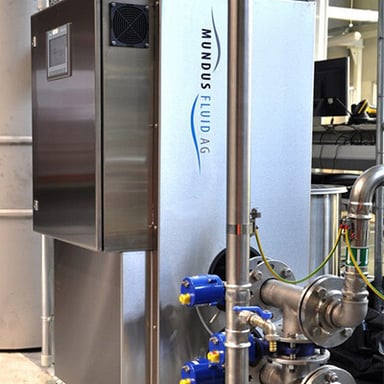Eliminate microorganisms with UV light and ultrasound

Chemical-free water treatment improves health and environmental protection
Water is not only the number one foodstuff, it is also indispensable in industrial processes. Reducing the consumption of resources such as water and energy is a declared goal of society and industry. The water required in industrial processes such as dip coating, cleaning and rinsing processes, leak testing, recooling plants and washing lines is therefore recirculated today. However, microorganisms such as bacteria, viruses and fungi form and multiply in the process, which can cause problems - from unpleasant odors and damage to systems and products to hazards for employees and the environment. To prevent this, chemicals and biocides are traditionally used. In many cases, however, this type of disinfection no longer achieves sufficient germ reduction. If the chemical agents are used over a longer period of time, microorganisms can become resistant to them - a development that is also known in human medicine as “hospital germs”.
Chemical-free alternative: UV light in combination with ultrasound
As an alternative to the treatment and disinfection of industrial, process and drinking water on an industrial scale, our customer Mundus Fluid AG has developed a solution based on short-wave UVC light and ultrasound. This makes the use of chemicals superfluous. In addition, microorganisms cannot develop resistance to UV light. Ultrasonic components designed for continuous operation are used in the disinfection systems, which are available with disinfection capacities of two to 250 cubic meters per hour. The temperature of the liquid to be disinfected can be between ten and 60 °C. The systems can be easily integrated into existing water supply and treatment systems and only require a small footprint, even with a high throughput. The individual operating parameters are controlled and set via a Siematic S7. An optional module enables remote monitoring of all system parameters so that disinfection can be monitored in a fully integrated manner. The systems are also equipped with a filter system that removes particulate impurities from the process water.
Disinfection with high efficiency - even with cloudy liquids
The number and radiation intensity of the UV lamps as well as the power and frequency of the ultrasonic system are adjusted to the respective application and the medium to be disinfected. The task of ultrasound is to break up clusters of germs in the liquid to be disinfected. This effect is based on the physical phenomenon of acoustic cavitation: the electrical signals generated by the ultrasonic generator are converted into mechanical vibrations by an ultrasonic transducer and transmitted into the liquid. This causes small bubbles to form in the medium, which grow and suddenly collapse. The resulting strong currents break up existing germ accumulations into small germ cells. This ensures that all microorganisms are killed in the shortest possible time when irradiated with the high-energy UV light, even at a high flow rate. The disinfection systems achieve an efficiency of 99.8 percent.
One of the special features of Mundus Fluid's disinfection systems is that even cloudy liquids can be disinfected. This is possible down to a turbidity of less than 100 FNU, scattered light measurement (angle 90°) in accordance with the ISO 7027 standard.
Economical and sustainable in series production
The disinfection systems are used to treat drinking water in hospitals, care homes and on ships, as well as to treat process water in car washes and in the automotive industry. Mercedes-Benz, for example, has been investing more heavily in resource-saving and environmentally friendly water treatment since 2019. The disinfection systems help to keep the water from leak testing systems, sprinkler systems and car washes in circulation for as long as possible, thus minimizing fresh water consumption. Combined with a modern filter system, the system enables water consumption to be more than halved. In addition, by dispensing with chemical disinfectants with constant disinfection, working conditions and occupational health and safety have improved, as has environmental protection.
Back to Blog page








